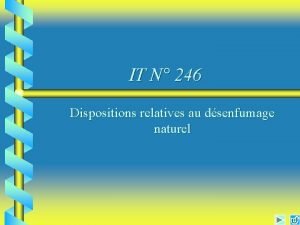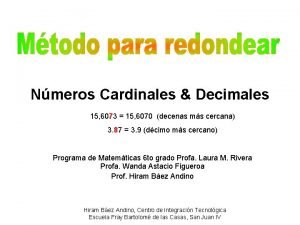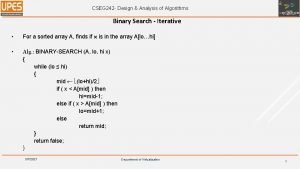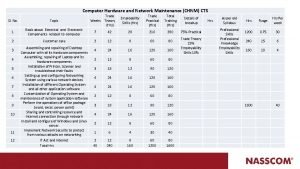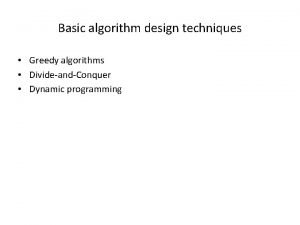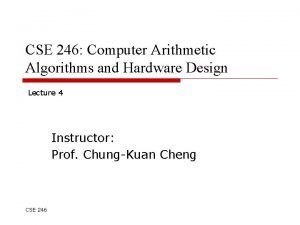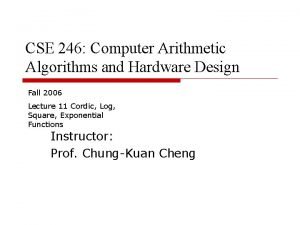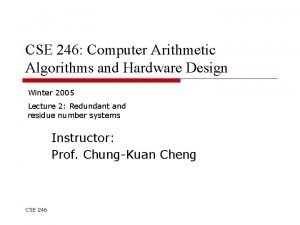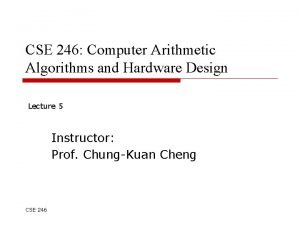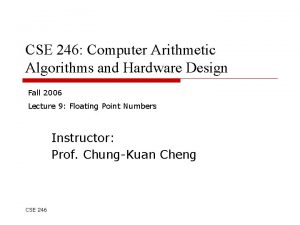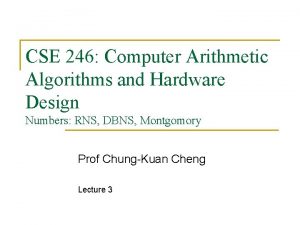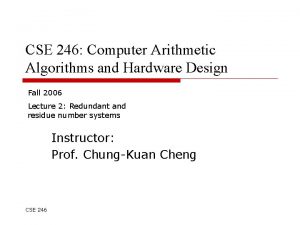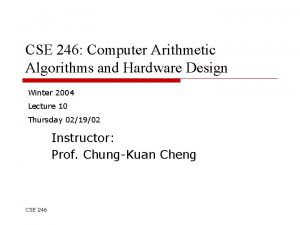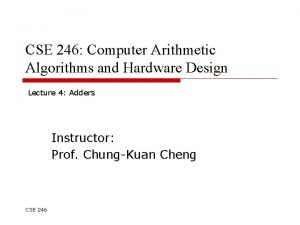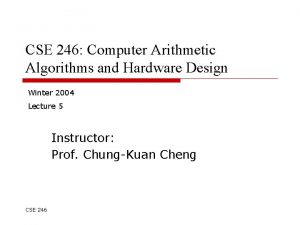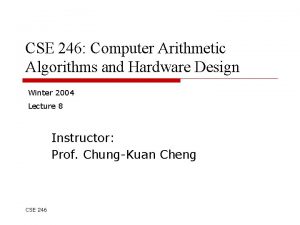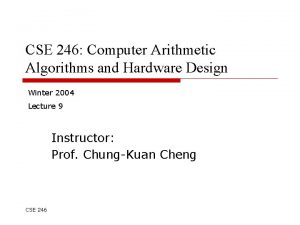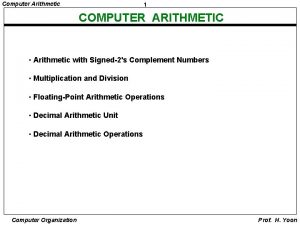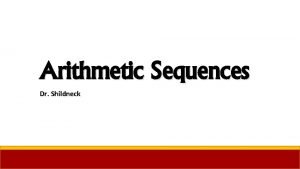CSE 246 Computer Arithmetic Algorithms and Hardware Design






























- Slides: 30

CSE 246: Computer Arithmetic Algorithms and Hardware Design Lecture 6. 1 Multiplication Arithmetic Instructor: Prof. Chung-Kuan Cheng CSE 246

Topics: n n CSE 246 Karatsuba’s Method (1962) Toom’s Method (1963) Modular Method FFT 2

Karatsuba’s Method U=2 n. U 1+U 0, V=2 n. V 1+V 0 o UV= 22 n. U 1 V 1+2 n(U 1 V 0+U 0 V 1)+U 0 V 0 = (22 n+2 n)U 1 V 1+2 n(U 1 -U 0)(V 0 -V 1)+(2 n+1)U 0 V 0 o T(2 n)<= 3 T(n)+cn T(2 k)<=c(3 k-2 k) T(n)=T(2 lgn)<=c(3 lgn-2 lgn)<3 cnlg 3=1. 585 CSE 246 3

Toom’s Method U=2 rn. Ur+…+2 n. U 1+U 0 o V=2 rn. Vr+…+2 n. V 1+V 0 o U(x)= xr. Ur+…+x. U 1+U 0 o V(x)= xr. Vr+…+x. V 1+V 0 o U(x)V(x)=W(x)= x 2 r. W 2 r+…+x. W 1+W 0 Set 2 r+1 equations: W(0)=U(0)V(0) W(1)=U(1)V(1) W(2 r)=U(2 r)V(2 r) o CSE 246 4

Toom’s Method o o T((r+1)n)<= (2 r+1)T(n)+cn T(n)<=cnlogr+1(2 r+1)<cn 1+logr+12 Theorem: Given e> 0, there exists a multiplication algorithm such that the number of elementary operation T(n) needed to multiply two n-bit numbers satisfies for some constant c(e) independent of n T(n)<c(e)n 1+e CSE 246 5

Toom’s Method o o o U=(4, 13, 2)16, V=(9, 2, 5)16 U(x)=4 x 2+13 x+2, V=9 x 2+2 x+5 W(x)=U(x)V(x) W(0)=10, W(1)=304, W(2)=1980 W(3)=7084, W(4)=18526 W(x)= x 2 r. W 2 r+…+x. W 1+W 0 CSE 246 6

Toom’s Method W(x)= x 2 r. W 2 r+…+x. W 1+W 0 o Rewrite W(x)= a 2 rx 2 r+…+a 1 x 1+a 0 where xk=x(x-1)…(x-k+1) W(x+1)-W(x)= 2 ra 2 rx 2 r-1+(2 r-1)a 2 r-1 x 2 r-2…+a 1 (W(x+2)-W(x+1))-(W(x+1)-W(x))= 2 r(2 r-1)a 2 rx 2 r-2+(2 r-1)(2 r-2)a 2 r-1 x 2 r-3…+2 a 2 o CSE 246 7

Toom’s Method W(*)=10, 304, 1980, 7084, 18526 o W’(*)=294, 1676, 5104, 11442 o W’’(*)=1382, 3428, 6338 o W’’(*)/2= 691, 1714, 3169 o W’’’(*)/2= 1023, 1455 o W’’’(*)/6= 341, 485 o W’’’’(*)/6= 144 o W’’’’(*)/24= 36 o W(x)= 36 x 4+341 x 3+691 x 2+294 x 1+10 =(((36(x-3)+341)(x-2)+691)(x-1)+294)x+10 = 36 x 4+125 x 3+64 x 2+69 x+10 o CSE 246 8

Toom’s Method 36 341 -3 x 36 36 233 691 -2 x 36 36 2 x 233 161 225 294 -1 x 36 36 CSE 246 1 x 161 1 x 225 125 64 69 9 10

Toom and Cook’s Method o Theorem: There is a constant c such that the execution time of Toom and Cook’s method is less than cn 23. 5 sqrt(lgn) cycles CSE 246 10

Modular Method (Schonhage) Recursive formula: q 0=1, qk+1=3 qk-1 o Thus, we have qk=1/2(3 k+1) o Relatively prime pi 6 qk-1, 6 qk+2, 6 qk+3, 6 qk+5, 6 qk+7 o Set six moduli mi=2 pi-1 o CSE 246 11

Modular Method o o Given U and V, Find W=Ux. V Compute ui=Umodmi vi=Vmodmi Compute wi=uixvimodmi Recover W T(n)=O(nlog 36)=O(n 1. 631) CSE 246 12

FFT Given U(t)=(u 0, u 1, …u. K-1), V(t)=(v 0, v 1, …v. K-1) Find P(t)=(p 0, p 1, …, p. K-1), where pt=sum(i+j=t mod. K) uivj o o o Set w=exp(2 pi/K), i. e. w. K=1 us= sum(0<=t<K) wstut vs= sum(0<=t<K) wstvt U(s)V(s)=(u 0 v 0, u 1 v 1, …, u. K-1 v. K-1) P(s)=U(s)V(s), ps=usvs ps= sum(0<=t<K) wstpt CSE 246 13

FFT o o o K>= 2 n-1, un=un+1=…=u. K-1=0 vn=vn+1=…=v. K-1=0 pt=sum(i+j=t mod. K)uivj =utv 0+ut-1 v 1+…+u 0 vt CSE 246 14

FFT (K=2 k , t=(tk-1, …, t 0)) o o Set A 0(tk-1, …, t 0)=ut , i. e. A 0(t)=ut Set A 1(sk-1, tk-2, …, t 0)= A 0(0, tk-2, …, t 0)+w 2 k-1 sk-1 A 0(1, tk-2, …, t 0) Set A 2(sk-1, sk-2, tk-3, …, t 0)= A 1(sk-1, 0, tk-3, …, t 0)+ k-2(s 2 k-2 sk-1)2 A (s w 1 k-1, 1, tk-3, …, t 0) Set Ak(sk-1, sk-2, sk-3, …, s 0)= Ak-1(sk-1, …, s 1, 0)+ w(s 0 s 1…sk-1)2 Ak-1(sk-1, …, s 1, 1) CSE 246 15

FFT (K=2 k , t=(tk-1, …, t 0)) o o o o Replace tk-1 with sk-1 k-1 s 2 k-1 sk-1 determines w Replace tk-2 with sk-2 k-2(s 2 k-2 sk-1)2 sk-1, sk-2 determines w Replace t 0 with s 0 sk-1, sk-2, …, s 0 determines w(s 0 s 1…sk-1)2 Binary s=(s 0, s 1, …, sk-1)2 CSE 246 16

FFT (K=2 k , t=(tk-1, …, t 0)) By induction, we have Aj(sk-1, …, sk-j, tk-j-1, …, t 0)= sum(tk-1, …, tk-j)w 2 k-j (sk-j, …, sk-1)2 (tk-1, …, tk-j)2 ut Ak(sk-1, …, s 0)= sum(tk-1, …, t 0) w(s 0, …, sk-1)2(tk-1, …, t 0)2 ut =us CSE 246 17

FFT: k=2 (00 ) (01 ) (10 ) (11 ) 1 u 0 (00 ) 1 1 1 u 1 (01 ) 1 w w 2 w 3 u 1 u 2 (10 ) 1 w 2 w 4 w 6 u 2 u 3 (11 ) 1 w 3 w 6 w 9 u 3 CSE 246 = 18

FFT: k=2 (00 ) (10 ) (01 ) (11 ) 1 1 u 0 (00 ) 1 1 u 2 (10 ) 1 w 4 w 2 w 6 u 2 u 1 (01 ) 1 w 2 w w 3 u 1 u 3 (11 ) 1 w 6 w 3 w 9 u 3 CSE 246 = 19

FFT: k=2 (00) (10) (01) (11) u 0 (00) 1 1 u 0 u 2 (10) 1 1 -1 -1 u 2 u 1 (01) 1 -1 w -w u 1 u 3 (11) 1 -1 -w w u 3 CSE 246 = 20

FFT: k=2 1 1 1 -1 -1 -w w -w = w 1 0 1 1 0 0 1 0 -1 0 1 -1 0 0 0 1 0 w 0 0 1 1 0 -w 0 0 1 -1 CSE 246 21

FFT: k=3 (000) (001) (010) (011) (000) 1 1 1 (001) 1 w w 2 w 3 w 4 (010) 1 w 2 w 4 w 6 w 8 w 10 w 12 w 14 (011) 1 w 3 w 6 w 9 w 12 w 15 w 18 w 21 (100) 1 w 4 w 8 w 12 w 16 w 20 w 24 w 28 (101) 1 w 5 w 10 w 15 w 20 w 25 w 30 w 35 (110) 1 w 6 w 12 w 18 w 24 w 30 w 36 w 42 (111) 1 w 7 w 14 w 21 w 28 w 35 w 42 w 49 CSE 246 22 (100) (101) (110) (111) 1 1 1 w 5 w 6 w 7

FFT: k=3 (000) (100) (010) (110) (000) 1 1 1 (100) 1 w 16 w 8 w 24 w 20 w 12 w 28 (010) 1 w 8 w 4 w 12 w 10 (110) 1 w 24 w 12 w 36 w 30 w 18 w 42 (001) 1 (101) w 2 1 (111) 1 1 w 6 w 14 w 1 w 20 w 10 w 30 w 5 w 25 w 15 w 35 (011) 1 w 12 w 6 w 18 w 3 w 15 (111) 1 w 28 w 14 w 42 w 7 w 35 w 21 w 49 23 w 5 (011) w 6 CSE 246 w 4 (001) (101) w 3 w 7 w 9 w 21

FFT: k=3 (000) (100) (010) (110) (000) 1 1 1 (100) 1 1 (010) 1 1 -1 -1 (110) 1 1 -1 -1 -w 2 (001) 1 -1 w 2 -w 2 w (101) 1 -1 w 2 -w (011) 1 -1 -w 2 w 3 -w 3 w -w (111) 1 -1 -w 2 -w 3 -w w CSE 246 24 (001) (101) (011) (111) 1 1 1 -1 -1 w 2 -w 2 -w w 2 w 3 -w 3 w 3

FFT: k=3 1 1 1 1 1 0 0 0 1 1 -1 -1 1 0 0 0 -1 0 0 0 1 1 -1 -1 w 2 -w 2 0 1 0 0 0 w 2 0 0 1 1 -1 -1 -w 2 w 2 0 1 0 0 0 -w 2 0 0 1 -1 w 2 -w 2 w -w w 3 -w 3 0 0 1 0 0 0 w 0 1 -1 w 2 -w w -w 3 0 0 1 0 0 0 -w 0 1 -1 -w 2 w 3 -w 3 w -w 0 0 0 1 0 0 0 w 3 1 -1 -w 2 -w 3 -w w 0 0 0 1 0 0 0 -w 3 1 0 0 0 1 0 -1 0 0 0 1 -1 0 0 0 0 1 0 w 2 0 0 0 1 1 0 0 0 1 0 -w 2 0 0 0 1 -1 0 0 0 0 1 1 0 0 0 1 0 -1 0 0 0 1 -1 0 0 0 0 1 0 w 2 0 0 0 1 1 0 0 0 1 0 -w 2 0 0 0 1 -1 CSE 246 = 25

FFT o o k-1 2 s us=u 0+u 1 s+u 2 2 k-1 k-2 2 2 us=u 0+u 2 s +…+u 2 k-2 s +u 1 s+u 3 s 3+…+u 2 k-1 s 2 k-1 us= Fe(s 2) + s. Fd(s 2) k-2 2 Fe(s )=u 0+u 2 s +…+u 2 k-2 s k-1 2 2 2 Fd(s )=u 1+u 3 s +…+u 2 k-1 s us= Fee(s 4)+s 2 Fed(s 4) + s[Fde(s 4) +s 2 Fdd(s 4)] CSE 246 s 2+…+u 26

FFT o o us=u 0+u 1 s+u 2 s 2+…+u 2 k-1 s 2 k-1 us= Fee(s 4)+s 2 Fed(s 4) + s[Fde(s 4) +s 2 Fdd(s 4)] us= Feee(s 8)+ s 4 Feed(s 8) + s 2[Fede(s 8)+ s 4 Fedd(s 8)] + s{[Fdee(s 8)+s 4 Fded(s 8)] +s 2[Fdde(s 8)+ s 4 Fddd(s 8)]} k-1 k 2 2 Fx…x(s )= Fx…xe(s ) + s Fx…xd(s ) CSE 246 27

FFT o o o us=u 0+u 1 s+u 2 s 2+u 3 s 3+u 4 s 4+u 5 s 5+u 6 s 6+u 7 s 7 us= Fe(s 2) + s. Fd(s 2) Fe(s 2)=u 0+u 2 s 2+u 4 s 4+u 6 s 6 Fd(s 2)=u 1+u 3 s 2+u 5 s 4+u 7 s 6 Fe(s 2)=Fee(s 4) + s 2 Fed(s 4) Fee(s 4)=u 0+u 4 s 4, Fed(s 4)=u 2+u 6 s 6 Fd(s 2)=Fde(s 4) + s 2 Fdd(s 4) Fde(s 4)=u 1+u 5 s 4, Fdd(s 4)=u 3+u 7 s 4 Fx(s=w 0)=Fx(s=w 4), Fx(s=w 2)=Fx(s=w 6), Fx(s=w)=Fx(s=w 5), Fx(s=w 3)=Fx(s=w 7) x=e, d (s 0, s 1, s 2)=(-, 0, 0), (-, 0, 1), (-, 1, 0), (-, 1, 1) Fxx(s=w 0)=Fxx(s=w 2)=Fxx(s=w 4)=Fxx(s=w 6), Fxx(s=w)=Fxx(s=w 3)=Fxx(s=w 5)=Fxx(s=w 7), xx=ee, ed, de, dd, (s 0, s 1, s 2)=(-, -, 0), (-, -, 1) CSE 246 28

FFT (Inversion) o ur== sum(0<=s<K)wrsus = sum(0<=s, t<K)wrswstut = sum(0<=t<K)utsum(0<=s<K)ws(t+r) =Ku(-r)mod. K sum(0<=s<K)wsj=K if jmod. K=0, 0 otherwise. CSE 246 29

FFT o o 2 n<=2 k g< 4 n, K=2 k Precision m= 6 k Let M= time of m-bit multiplication Total time to multiply n-bit numbers O(n)+O(Mnk/g) CSE 246 30
 Fftooo
Fftooo 0110100101
0110100101 En un zoológico hay 246 aves
En un zoológico hay 246 aves It 246
It 246 Afman 10-246
Afman 10-246 Mining of massive datasets stanford
Mining of massive datasets stanford Write the highlighted digits place and value 567
Write the highlighted digits place and value 567 Junghoo cho ucla
Junghoo cho ucla Hyperglycemie nhg
Hyperglycemie nhg Ds. p. van veen
Ds. p. van veen 15 diezmilésimos en decimales
15 diezmilésimos en decimales Cs246 stanford
Cs246 stanford Round 215 to the nearest hundred
Round 215 to the nearest hundred Cs 246 stanford
Cs 246 stanford Design and analysis of algorithms syllabus
Design and analysis of algorithms syllabus Introduction of design and analysis of algorithms
Introduction of design and analysis of algorithms Binary search in design and analysis of algorithms
Binary search in design and analysis of algorithms Introduction to the design and analysis of algorithms
Introduction to the design and analysis of algorithms Design and analysis of algorithms
Design and analysis of algorithms Design and analysis of algorithms
Design and analysis of algorithms Design and analysis of algorithms
Design and analysis of algorithms Data representation and computer arithmetic
Data representation and computer arithmetic Computer networks routing algorithms
Computer networks routing algorithms Algorithm for line drawing in computer graphics
Algorithm for line drawing in computer graphics Hardware and network maintenance
Hardware and network maintenance Hardware and software for computer graphics
Hardware and software for computer graphics Computer software definition
Computer software definition A computer system consists of both hardware and software.
A computer system consists of both hardware and software. Algorithm design techniques
Algorithm design techniques Algorithms for visual design
Algorithms for visual design Algorithms for visual design
Algorithms for visual design



